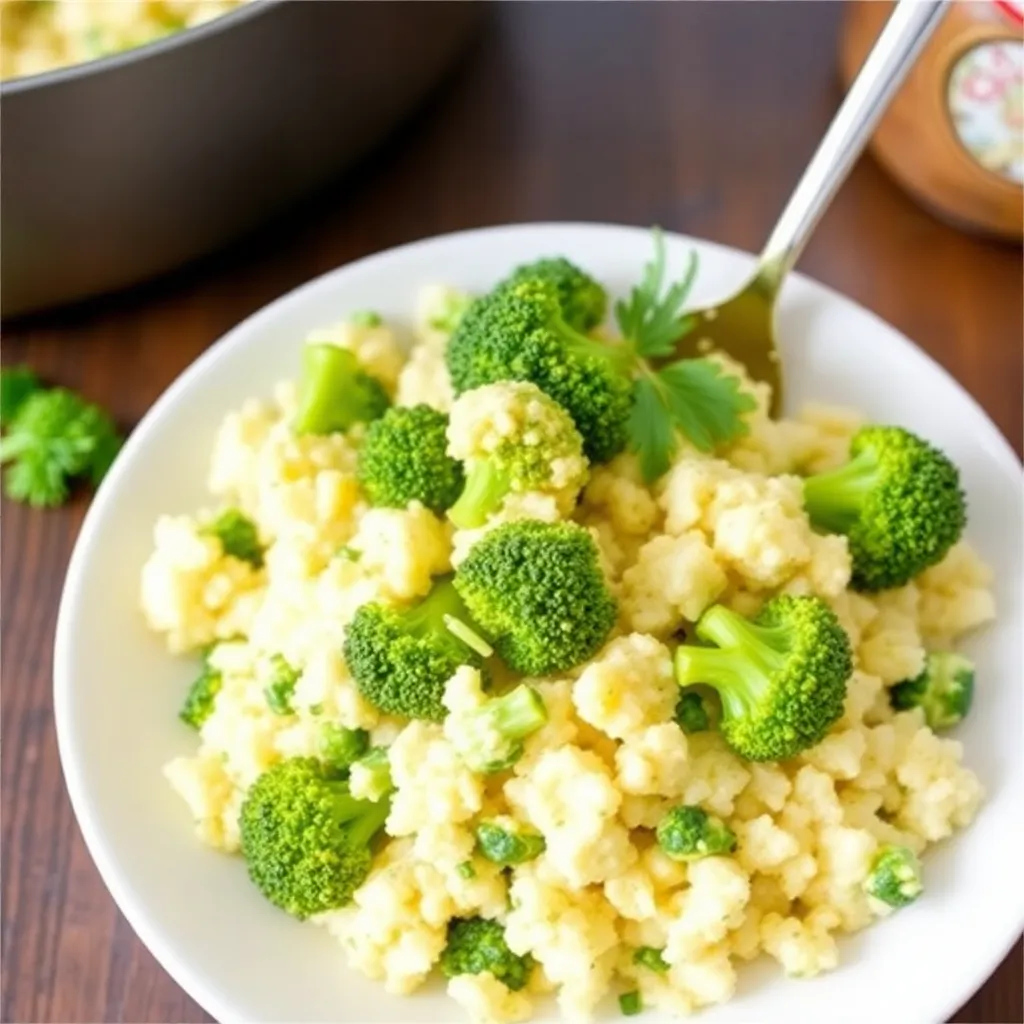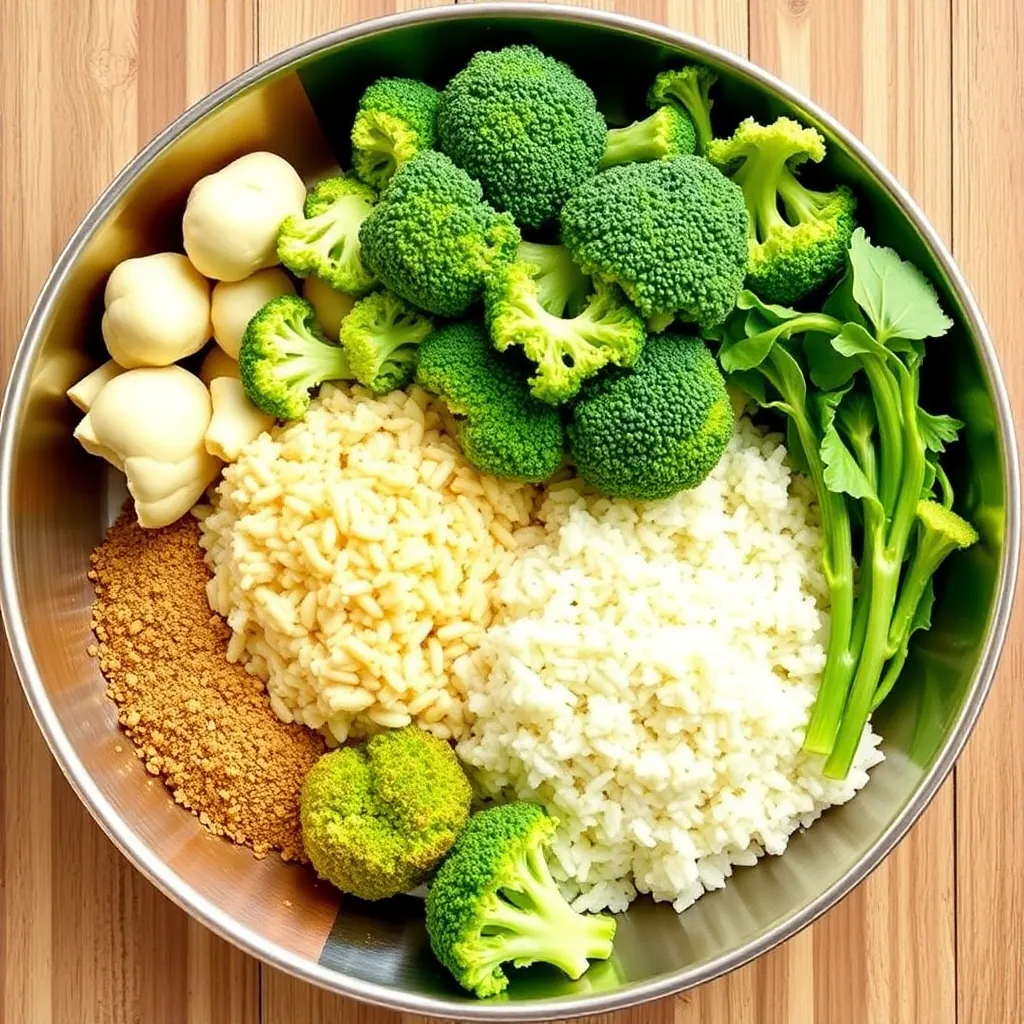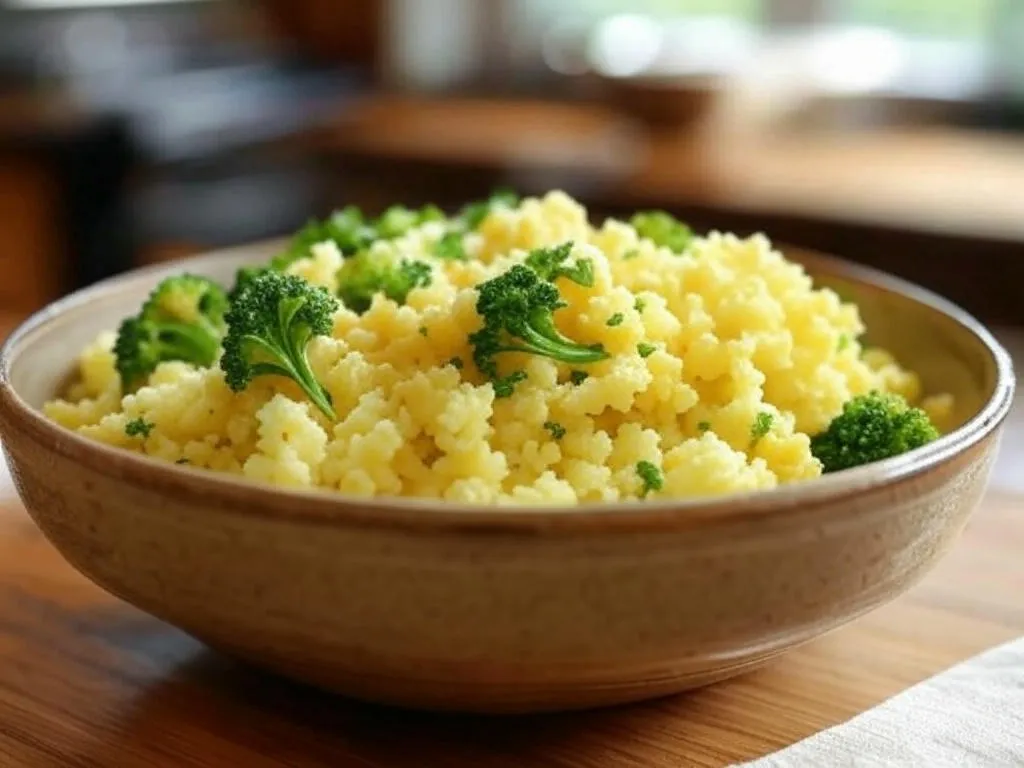Introduction
In today’s fast-paced world, finding a meal that is both delicious and nutritious can be a challenge. Enter Cheesy Broccoli Cauliflower Rice—a dish that perfectly marries flavor with health benefits. Whether you’re looking for a hearty side dish or a light main course, this recipe is designed to satisfy your cravings without compromising on nutritional value. In this article, we dive deep into the origins of this creative dish, explain the science behind its ingredients, and provide a step-by-step guide that guarantees a perfectly balanced, cheesy, and veggie-packed meal.

Why Choose Cheesy Broccoli Cauliflower Rice?
A Healthy Alternative to Carb-Heavy Sides
Traditional rice dishes can be calorie-dense and high in carbohydrates, which might not fit everyone’s dietary needs. By substituting with finely processed broccoli and cauliflower, you create a dish that:
- Lowers Caloric Intake: The vegetable base is low in calories compared to traditional grains.
- Boosts Fiber: Both broccoli and cauliflower are excellent sources of dietary fiber, aiding digestion and contributing to satiety.
- Offers Rich Nutrients: These cruciferous vegetables are packed with vitamins C, K, and a host of antioxidants that support overall health.
Flavor and Texture: The Cheesy Factor
Adding cheese to this vegetable medley isn’t just about creating a comforting dish—it’s about bringing together a rich, savory flavor that elevates the natural taste of the vegetables. Cheese also adds:
- Creaminess: A smooth texture that contrasts delightfully with the slight crunch of the broccoli and the tenderness of the cauliflower.
- Protein: Depending on the type of cheese used, you can also enjoy an additional boost of protein, making the dish even more satisfying.
- Versatility: With many cheese options available—from sharp cheddar to mozzarella or even a blend of Italian cheeses—you can tailor the recipe to suit your taste preferences.
Ingredients: A Detailed Breakdown
The success of any recipe begins with its ingredients. In our approach, every component is chosen not just for flavor but also for its nutritional profile and ease of preparation. Below is an in-depth look at each ingredient and why it matters.
1. Broccoli
- Nutritional Benefits: Rich in vitamins C and K, broccoli also contains sulforaphane—a compound known for its potential cancer-fighting properties.
- Texture and Flavor: Provides a satisfying crunch when lightly steamed, contrasting with the soft texture of cauliflower.
- Tips: Choose bright green, firm stalks and florets; avoid any with yellowing spots to ensure optimal flavor and nutrition.
2. Cauliflower
- Nutritional Benefits: Low in calories yet high in fiber, cauliflower is an excellent source of vitamin C and folate. It also contains antioxidants that may help reduce inflammation.
- Texture and Flavor: When processed into “rice,” cauliflower takes on a grain-like texture that mimics traditional rice, making it an excellent low-carb alternative.
- Tips: Use fresh, firm cauliflower heads for the best consistency when pulsing in a food processor.
3. Cheese
- Nutritional Benefits: Depending on the type, cheese can be a good source of protein, calcium, and essential fatty acids. It adds a creamy richness that is hard to beat.
- Texture and Flavor: A well-chosen cheese will melt uniformly, enveloping the vegetables in a layer of deliciousness.
- Tips: For a robust flavor, sharp cheddar works well; however, you can experiment with mozzarella, parmesan, or even a mix of your favorites. Ensure you use a cheese that melts smoothly without becoming oily.
4. Fresh Herbs and Seasonings
- Nutritional Benefits: Herbs such as basil, parsley, or thyme are low in calories and add essential vitamins and antioxidants.
- Texture and Flavor: Fresh herbs brighten up the dish with aromatic notes and a burst of flavor that complements the mild taste of the vegetables and cheese.
- Tips: Finely chop your herbs and add them towards the end of the cooking process to preserve their delicate flavors.
5. Olive Oil or Butter
- Nutritional Benefits: A small amount of healthy fat helps your body absorb fat-soluble vitamins present in broccoli and cauliflower.
- Texture and Flavor: Adds a subtle richness that enhances the overall mouthfeel of the dish.
- Tips: Use extra-virgin olive oil for a healthier option or unsalted butter for a richer taste. Remember, moderation is key.
6. Salt, Pepper, and Optional Spices
- Nutritional Benefits: While salt is essential in small quantities, it’s important to balance its use to avoid excessive sodium intake.
- Texture and Flavor: Pepper, garlic powder, and a pinch of red chili flakes can enhance the flavor profile without overpowering the natural taste of the vegetables.
- Tips: Experiment with your favorite spice blends—smoked paprika or even a touch of cumin can add an exciting twist to the dish.

Step-by-Step Preparation Guide
Creating the perfect Cheesy Broccoli Cauliflower Rice requires attention to detail. Follow this guide for a step-by-step approach that ensures each element is perfectly executed.
Step 1: Preparation of Vegetables
- Washing and Cutting: Begin by thoroughly washing both the broccoli and cauliflower. Remove the leaves and cut the florets into manageable pieces. For broccoli, make sure to trim the tough stems.
- Processing: Using a food processor, pulse the cauliflower until it resembles rice. Do not over-process, as you want to retain a slight texture.
- Pre-Cooking: Lightly steam or blanch the broccoli florets for 3–4 minutes until they are tender yet still crisp. This process preserves the nutrients while softening the vegetables just enough for mixing.
Explanation: Pre-cooking the broccoli ensures that it does not remain too raw compared to the cauliflower rice, creating a harmonious texture in the final dish.
Step 2: Melting the Cheese
- Choosing the Cheese: Decide whether you want a single type of cheese or a blend. Shred or cube your cheese to facilitate even melting.
- Heating: In a large pan, gently warm a small amount of olive oil or butter over medium heat. Add the cheese slowly, stirring continuously to avoid clumping.
- Combining: Once the cheese starts to melt and become smooth, it creates a luscious sauce that will coat the vegetables.
Explanation: Gradually melting the cheese over moderate heat prevents it from separating or becoming greasy, ensuring a consistent texture that enhances every bite.
Step 3: Combining the Vegetables with Cheese
- Mixing: Add the processed cauliflower rice and steamed broccoli to the pan with the melted cheese. Stir gently until the vegetables are evenly coated.
- Seasoning: Sprinkle in salt, pepper, and your choice of spices. Add freshly chopped herbs at this stage.
- Simmering: Allow the mixture to simmer on low heat for 3–5 minutes. This process helps the flavors meld together and the cheese to bind the ingredients.
Explanation: The simmering step is crucial. It allows the dish to develop depth of flavor while ensuring that the heat is evenly distributed across the vegetables.
Step 4: Final Touches and Plating
- Adjusting Flavors: Taste the dish and adjust the seasoning if necessary. A dash more salt or a sprinkle of additional herbs can make a significant difference.
- Presentation: Transfer the mixture to a serving bowl or individual plates. Garnish with a few extra fresh herbs or a light drizzle of olive oil for added shine.
- Serving Suggestion: Serve hot as a standalone dish or alongside your favorite protein for a balanced meal.
Explanation: Proper plating not only enhances visual appeal but also prepares the dish for immediate consumption, preserving the ideal texture and flavor.

Cooking Techniques for Perfect Texture and Flavor
Creating a dish that is both visually appealing and delicious requires attention to technique. Below are several tips and tricks honed by culinary experts:
1. Temperature Control
- Why It Matters: Cooking over medium to low heat is essential for melting cheese slowly. High heat can cause the cheese to burn or separate, which ruins the texture.
- Tip: Use a heavy-bottomed pan to distribute heat evenly. This minimizes hot spots that might cause uneven cooking.
2. Consistency in Vegetable Processing
- Why It Matters: The key to a harmonious dish is ensuring that both the broccoli and cauliflower are of similar sizes and textures. Overprocessing the cauliflower can lead to a mushy consistency, while under processing might leave it too chunky.
- Tip: Pulse the cauliflower in short bursts until it achieves a rice-like texture. Check frequently to ensure you’re not overdoing it.
3. Layering Flavors
- Why It Matters: Layering ingredients and flavors is an art that can elevate a simple recipe into a gourmet dish.
- Tip: Start with the aromatics (such as garlic or onion) if you choose to add them, then build your dish by incorporating the cheese and finishing with fresh herbs. This method maximizes the depth of flavor and preserves the integrity of each ingredient.
4. Balancing Moisture
- Why It Matters: Vegetables like broccoli and cauliflower naturally contain water. Too much moisture can cause the dish to become watery, while too little may prevent the cheese from melding properly.
- Tip: After pre-cooking, allow the vegetables to drain slightly on paper towels. When combining with the cheese, ensure that any excess moisture is evaporated during the simmering process.
Variations and Customizations
One of the greatest strengths of Cheesy Broccoli Cauliflower Rice is its versatility. Here are several ways to customize the recipe to suit various tastes and dietary needs:
1. Protein Boost
- Chicken or Turkey: Add diced, cooked chicken or turkey to transform the dish into a hearty meal. Sauté the meat with garlic and herbs before mixing it into the vegetable-cheese blend.
- Plant-Based Proteins: For vegetarians or vegans, consider adding chickpeas, lentils, or tofu. Marinate tofu cubes in a light seasoning blend before lightly frying or baking them.
- Seafood Option: Lightly seared shrimp or fish can be mixed in for a seafood twist that remains light yet satisfying.
2. Spice It Up
- Heat Variations: If you enjoy a kick, add red pepper flakes or a dash of cayenne pepper. These spices complement the creamy cheese without overwhelming the natural flavor of the vegetables.
- Herbal Accents: Experiment with fresh basil, cilantro, or even rosemary for different aromatic profiles. Each herb brings its unique note, enhancing the dish’s overall complexity.
3. Cheese Alternatives
- Lighter Options: For a lower-fat version, try using part-skim mozzarella or a blend of cheeses with lower fat content.
- Non-Dairy Options: If you’re dairy-free, look for vegan cheeses that melt well. Nutritional yeast is another option that adds a cheesy flavor without any dairy.
- Flavor Enhancers: A small amount of parmesan sprinkled on top before serving can add a delightful umami kick.
4. Additional Veggies
- Leafy Greens: Spinach or kale can be added for extra vitamins and a burst of color.
- Root Vegetables: A few finely diced carrots or bell peppers can introduce a subtle sweetness and additional texture.
- Mushrooms: Sautéed mushrooms add an earthy flavor that pairs beautifully with the richness of the cheese.
Explanation: These variations allow you to tailor the dish to your nutritional needs and flavor preferences, ensuring that every iteration of the recipe remains exciting and adaptable.
Nutritional Benefits and Health Perks
Beyond its delectable taste, Cheesy Broccoli Cauliflower Rice stands out for its nutritional advantages. Here’s why this dish can be a great addition to your diet:
1. Low-Carb and High-Fiber
- Low-Carb Alternative: Replacing traditional rice with vegetables helps lower the overall carbohydrate content of your meal, making it a suitable option for low-carb and ketogenic diets.
- Fiber-Rich: Both broccoli and cauliflower are high in fiber, which aids in digestion, helps regulate blood sugar levels, and promotes a feeling of fullness.
2. Rich in Vitamins and Antioxidants
- Vitamins and Minerals: The dish is loaded with vitamins C and K, along with folate and potassium. These nutrients are essential for immune function, bone health, and overall cellular function.
- Antioxidant Properties: The antioxidants found in cruciferous vegetables may help combat oxidative stress and reduce inflammation, contributing to long-term health benefits.
3. Balanced Macronutrients
- Protein and Healthy Fats: The inclusion of cheese not only enriches the flavor but also provides protein and calcium. When combined with the natural goodness of vegetables, this creates a balanced dish that supports muscle repair and bone strength.
- Satiety and Energy: The combination of fiber, protein, and healthy fats helps maintain steady energy levels and reduces unhealthy snacking by keeping you full longer.
4. Suitable for Various Diets
- Gluten-Free: Naturally gluten-free, this recipe is an excellent choice for those with gluten sensitivities or celiac disease.
- Customizable to Dietary Needs: With simple tweaks—such as using vegan cheese or adding lean proteins—the recipe can be adapted to fit a range of dietary restrictions.
Explanation: By focusing on whole, nutrient-dense ingredients, this dish not only delights your taste buds but also supports a balanced, healthy lifestyle.
Cooking Tips and Tricks
Even with a great recipe, sometimes small adjustments can make a big difference. Here are some additional tips from experienced home cooks and nutrition experts:
- Preheat Your Pan: Always warm your pan before adding ingredients. This helps prevent sticking and ensures even cooking.
- Don’t Rush the Melting Process: Low and slow is the mantra for melting cheese. This ensures it forms a smooth sauce rather than a clumpy mess.
- Taste as You Go: Seasoning can always be adjusted. Taste the dish during the cooking process to ensure the flavors remain balanced.
- Store Leftovers Properly: If you have leftovers, store them in an airtight container in the refrigerator for up to three days. Gently reheat on the stove or microwave to retain the best texture.
- Experiment with Texture: If you prefer a crunchier bite, reserve a small portion of lightly steamed broccoli and sprinkle it on top before serving.
Conclusion
Cheesy Broccoli Cauliflower Rice is more than just a trendy low-carb alternative—it’s a celebration of health, flavor, and culinary creativity. By thoughtfully combining nutrient-rich vegetables with a velvety cheese sauce, this dish offers a perfect balance of indulgence and nourishment. Whether you’re looking to impress guests at a dinner party or simply need a quick and healthy meal for a busy weeknight, this recipe is sure to become a staple in your culinary repertoire.
Through this detailed guide, we’ve explored every aspect of the dish—from ingredient selection and preparation techniques to tips on customization and nutritional benefits. By following these carefully crafted steps, you can enjoy a dish that not only meets your dietary needs but also delights your taste buds with its rich, cheesy flavor and satisfying texture.
We encourage you to experiment, adjust, and make this recipe your own. Cooking is as much about creativity as it is about precision, and every adjustment you make reflects your unique culinary
d diet. From its thoughtfully selected ingredients to the precise cooking methods, every element of this dish is designed to deliver both taste and nourishment. Enjoy this recipe as a hearty side dish, or elevate it into a complete meal by adding your favorite proteins and extras. Happy cooking!
Frequently Asked Questions (FAQ)
1. Can I prepare Cheesy Broccoli Cauliflower Rice ahead of time?
Absolutely. This dish can be made in advance and refrigerated. However, for the best texture, reheat gently on the stove over low heat, stirring occasionally to redistribute the melted cheese evenly.
2. What type of cheese works best for this recipe?
While sharp cheddar is a popular choice for its bold flavor, you can experiment with mozzarella, Monterey Jack, or even a blend of cheeses. The key is to choose a cheese that melts well and enhances the overall creaminess of the dish.
3. How do I avoid a watery consistency?
To prevent excess moisture, ensure the vegetables are properly drained after washing and pre-cooking. Blanch or steam them until just tender, then let them sit briefly on paper towels before combining with the cheese.
4. Can I make this dish dairy-free?
Yes. Substitute traditional cheese with high-quality vegan cheese alternatives or nutritional yeast for a cheesy flavor without the dairy. Adjust seasonings to taste, as vegan cheeses can have different melting properties.
5. Is this dish suitable for low-carb diets?
Definitely. By replacing traditional rice with a blend of broccoli and cauliflower, you significantly reduce the carbohydrate content while increasing fiber and nutrient density.
6. Can I add other vegetables?
Certainly. Feel free to experiment by adding leafy greens like spinach or even mushrooms for extra flavor and texture. The recipe is highly adaptable to your personal taste preferences.
7. What are the best herbs to use?
Fresh herbs like parsley, basil, or thyme are excellent choices. They not only add vibrant color but also enhance the overall aroma and flavor profile of the dish.
8. How do I store leftovers?
Store any leftovers in an airtight container in the refrigerator. Consume within 2–3 days for optimal freshness. Reheat gently to avoid overcooking the vegetables and melting the cheese too much.
9. Can I serve this as a main dish?
Yes. While it works wonderfully as a side, adding proteins such as chicken, tofu, or shrimp can transform it into a complete, satisfying meal.
10. What equipment do I need?
A food processor for the cauliflower “rice,” a large pan for melting the cheese and combining ingredients, and basic kitchen utensils like spatulas and cutting boards will suffice.
Frequently Asked Questions (Extended)
Q: What is the best way to reheat Cheesy Broccoli Cauliflower Rice without losing its texture?
A: Reheat gently on the stovetop over low heat with a splash of water or broth. Stir frequently to ensure even heating and to prevent the cheese from clumping.
Q: Can I freeze this dish for later use?
A: While you can freeze it, the texture of the vegetables might change slightly upon thawing. For best results, enjoy it fresh or store leftovers in the refrigerator for up to 3 days.
Q: How can I adjust the recipe for a spicier version?
A: Simply add red chili flakes, a dash of cayenne pepper, or even a finely chopped jalapeño during the seasoning phase. These will infuse a gentle heat that complements the creaminess of the cheese.
Q: Are there any suggested pairings for this dish?
A: Yes, it pairs wonderfully with grilled chicken, a crisp salad, or even a light tomato-based soup. For a vegetarian twist, toss in some roasted chickpeas or a side of sautéed greens.
Q: How do I ensure the cheese remains smooth and doesn’t separate?
A: Melt the cheese slowly over medium-low heat while stirring continuously. Avoid overheating, which can cause the fats to separate, leading to an undesirable texture.
Q: What should I do if I find the dish too rich?
A: You can balance it out by adding more steamed vegetables or a squeeze of lemon juice to brighten the flavors. Adjust seasonings gradually until you reach your desired taste.


Leave a Reply